
ELECTRONICS!
FREE Schematics, Assembly Coding, Instructions
My Life and Fun - Wayne Simister
![]() E-Mail Wayne Simister -- wsimister@hotmail.com
E-Mail Wayne Simister -- wsimister@hotmail.com

ELECTRONICS!
FREE Schematics, Assembly Coding, Instructions
My Life and Fun - Wayne Simister
![]() E-Mail Wayne Simister -- wsimister@hotmail.com
E-Mail Wayne Simister -- wsimister@hotmail.com
My first introduction to electronics began with making a Heathkit photographic enlarger timer using those old fashioned tubes back in about 1950. This love only grew as the years rolled on and the exciting new world of transistors emerged. Then came CMOS circuitry which threw open the doors to even wider horizons. Things are only getting better.
Today, I find myself fascinated. There are two sections to this home page .... first, my latest Atmel AVR micro-controller projects. The second section of this site includes my older projects using discrete components.
You will note that many of these projects utilize my earlier patent made through the University of Utah for Touch Plate Lighting. This circuitry is also implemented in many projects here. The idea behind it is using in-phase feedback on the shielded control line cable to allow consistent and sensitive operation with varying lengths of long shielded cable lengths. Such use allows only a metal plate connected to the inner conductor of the control line to act as a switching control point. All electronics, then, are located in the module at the light or power strip. Capacitance touch plates never wear out providing highly reliable switching control. An added advantage is that many touch plates at remote locations can control this module.
You will find kid's toys such as the stop light and single cell LED flashlight. There is a unique and very functional burglar alarm. There is an electronic combination lock for opening your garage door from the outside. Also, you'll find some timers with alarm functions. Then my other latest development is "The One Button Home." This allows any single touch plate in any room to turn off any other light or appliance anywhere else in the home. And there is more. Full description, instructions, schematic, and assembly coding for these and other Atmel micro-controller projects are included at this site.
I hope you enjoy some of these devices and are able to share some of my excitement and love of electronics.
Humor for today:
An alternate download site for these files below is at www.simister.net/~wayne/onebutton/.
Also at this alternate site are my latest One Button Home and One Button Home 2 projects.

Part 1 -- These projects use Atmel AVR ATTINY2313, AT90S2313, and ATMega8L micro-controller chips:

April 14, 2012. Turn on any room light or appliance from any other room. Using a single touch plate button, one can control any light or appliance in the home. This system developed over several years, incorporates a long, but small, shielded control line connected to one or more conductive touch plates. It utilizes the long control line touch plate patent held by Wayne Simister.
There are no electronics in the touch plates. All electronics are housed in a module located as part of or near the light or appliance being controlled. Each module is connected by a single pair telephone type line which connects between the slave, all other slaves, and the central Master unit. This master unit supplies both power and control data to and from each slave module via the telephone type interconnecting cable.
To turn on the light locally, a single touch to the touch plate is used. To turn on a remote slave in another room, a combination of touches are used. For example, to turn on the light in the garage, you will use a given code such as 12. Twelve can be sent by a longer touch (approximately 3/4ths second) plus two short (less than 1/4th second) touches to the touch plate. This combination of touches signal the garage unit to go on or off. If the garage light comes on, you hear a beep from the local slave unit. It the light went off, no beep is heard. You thus have feedback any time a light or appliance is turned on remotely.
A short (DIT) touch counts ONE and adds one to the total count. A longer (3/4th second touch - DAH) adds ten to the total count. A hold down touch (wait for a blink of the LED). Each blink of an LED adds 50 to the total count.
Consult this page for further information on advantages and many of the other functions the OBH2 system offers.

Originally designed for use to prevent pipes from freezing, this project was improved upon to maintain a set temperature for other tasks as well.
January 12, 2014 - Set the desired temperature you wish to turn on --- either a heating lamp or a cooling fan. Whether you wish the power outlet to heat or cool is selectable. The thermistor coupled to the micro-controller assures that when a temperature drops above or below the programmed temperature, power will be applied to the AC outlet. A read of the thermistor happens about every 1 1/2 to 2 minutes. Immediately after this temperature reading is made, the relay is switched if a temperature goes above or below that pre-set switching temperature.
This set switching temperature is remembered even after the unit has been powered down. But it can be set to a new value when desired. This new temperature will replace the older permanently set temperature.
Immediately after each 1 1/2 to 2 minute interval reading is made, the LED flashes out the current temperature number in a four digit format. If desired, the option to beep out this current value is also selectable.
A single button controls all operations. The power consumption is well under one watt to power the electronics continuously.

It's immune to power failures because it's powered by the SUN.
September 19, 2013 (update of former Solar Timer). It's a clock, visible day or night. It's a timer. It's an alarm clock. It's an interval timer.
Further, minimal parts are required ---- only one button, one bi-color LED, and a Sonalert --- all powered by a small 6-volt solar cell charging 3 NiMH AA cells. Using simple Hold Down, DAH and DIT entries, one has complete control over this small, very accurate clock/timer.
Day-of-Week, and Time is flashed out every 30 seconds. This sequential flashout of time from the bi-color LED can be interrupted by a push of the button. The unit then goes into an interval timer mode.
A clock correction system is on board which can easily be re-programmed and permanently memorize this correction in EEPROM memory. Anytime the chip is rebooted, these corrections are restored. The on-board relay can control other devices such as a radio.

August 6, 2011. Need an accurate time keeper? The Accu Alarm Clock is a micro-controller project that makes a clock which can be very accurately adjusted for long-term, time accuracy. Further, it allows up to sixteen toggles of a power outlet. These toggle settings can be made daily or on specific days of the week.
A single bi-colored LED flashes out day-of-week and time every 30 seconds.
Crystal controlled, this project allows the clock to be tracked over several months to fine tune the clock correction routine. By doing so, many variables, including temperature, which may affect crystal frequency can be averaged out over many weeks. Expected accuracy can be up to two seconds per month.
This design allows up to 10 minutes of power interruption. However, none of the clock correcton or crystal divider settings are lost. They are stored in EEPROM memory which is read at boot up after power is restored.
A touch plate control system capable of attaching up to 150 feet of shielded control line gives the capability of this Accu Clock to be controlled at multiple points. Reprogramming of the clock correction is done through the touch plate.

April 21, 2011. While designed primarily as a toy for children's entertainment, this project serves as a very sensitive instrument to audibly listen to earth's magnetic field. It has both a low sensitivity as well as high sensitivity mode.
Children can dance with a small magnet near the sensor to produce a myriad of tones.
It utilizes the Speake FGM-3 flux gate sensor. A crystal referenced frequency is used to beat against the FGM-3 signal to yield an audio signal which monitors extremely small changes in the earth's magnetic field --- or surrounding fields.

Ultimate Night Light
November 21, 2010 version. This night light turns the LEDs on at sunset and off at sunrise. Times are determined by an EEPROM memory table which can be programmed with times desired for your region. Time changes occur every fifteen days.
A separate LED flashes out the Standard Time day of week every 30 seconds. A touch plate rather than mechanical switch is used to enter data.
A capacitor with sensitive gate SCR are used to power the unit, thus it is very power efficient.

August 30, 2010 version of the Timer. In addition to earlier models, this one adds a convenient metronome and additional "Favorites" save time. It has a count up timer as well as a beep out of the time that has elapsed after the "finished" alarm is heard. (How many minutes did I over bake the rolls!). Lastly, it will beep on any programmed interval .... from seconds to hours.
Short dit pushes of the button add one minute to the total time. A longer, dah, (3/4 second push) add ten minute increments to the total time. You can even add hours. This is done by holding down the button and waiting for a beep. Each beep adds an hour to the total time.
No power is drawn from the battery when off. During use, it draws 2-4 ma from the 1.5 volt AA battery.

Set this out where all can see and it flashes out your address in the evening by using sequential flashes. IF you wish to add your street name, that, too can be flashed out using Morse code. A single push button is used to program the ATTiny2313V chip. This programmed information is remembered even during power downs.
Always a good conversation piece, and being solar powered, not much need for maintenance. A $3.00 Westinghouse Solar Garden Light was used for the solar cell and LED voltage step up circuitry. (Added July, 2010)

Having difficulty keeping track of the pills you take. Up to four pills can be programmed. It is designed to change the four LED lights at midnight each day to indicate if a pill should be taken or not that day. A double flash is given at the start of each new day for a pill that is to be taken. The flash can be changed to a single flash once you have taken that pill.
An ATTINY2313V micro-controller draws very little power so costs but pennies a year to keep in operation. (Added July, 2010)

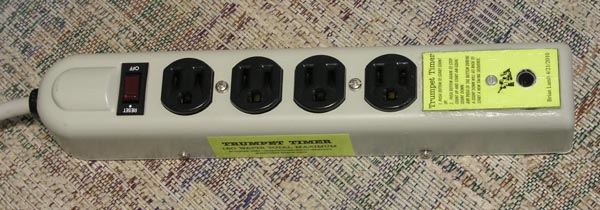
Trumpet Timer/Silent Metronome
Practice Trumpet Timer plus Silent Metronome
Plug a light into this power strip, press the button to start an interval. After the desired interval, press the button again. The time between button pushes flash the light on and off for that duration. This on/off cycle repeats itself. The interval can be less than a second and longer than a day.
Short intervals make it a silent metronome.
The unit was designed at the request by grandson, Brian Lamb. He needed a timer with which to practice his trumpet playing. It is recommended that one rest for the same amount of time one plays. This timer fills that bill. The inexpensive ATTINY2313 micro-controller is used for this project. (Added April 28, 2010)

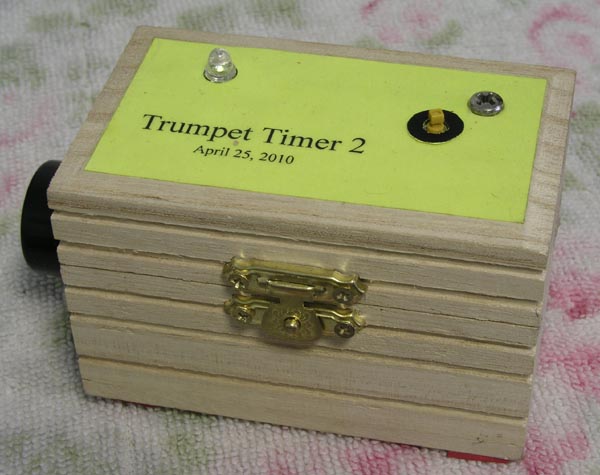
Trumpet Timer2
Portable Practice Trumpet Timer
This is the portable version of "Trumpet Timer/Silent Metronome." A series of three beeps is heard at the end of a set timing duration. It will not recycle as does "Trumpet Timer/Silent Metronome." No metronome function exists for this device. Press the button to start an interval. After the desired interval, press the button again. The time between button pushes determines the wait time before the Sonalert alarm sounds.
The unit requires one AA battery. The inexpensive ATTINY2313 micro-controller is used for this project. (Added April 28, 2010)

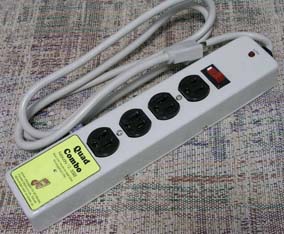
QUAD COMBO
Four AC Outlets Individually Controlled by Coded Touches of Touch Plate
The name, Quad Combo, was given to this unusual but useful project. Construct this low component count capacitance touch plate switch with long control line capability. Touch plates can be located at multiple locations. Besides being an ordinary touch switch, Quad Combo can be easily programmed to accept only certain dit-dah touches of the touch plate. Each of the four outlets can have a different code. This code can be as simple as one dit (short) or dah (long) touch, -- on up to as many as 254 dit-dah combinations of touches. The device is powered by an efficient capacitive power supply keeping operation costs to pennies a year. The inexpensive ATTINY2313 micro-controller does a stellar job for this project. (Added February 17, 2008)

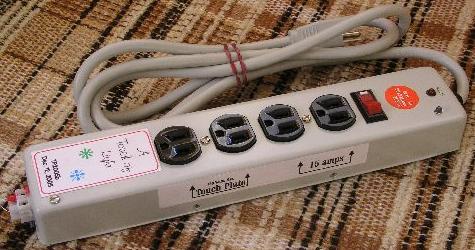
A Touch of Light
Here's a neat project. This is a very useful touch plate circuit design. Besides being an ordinary touch switch, this one adds capabilities to give the home a lived-in look. In addition, "A Touch of Light" has a programmable on time of up to 255 hours in fifteen minute segments. Small component count and reliable control are achieved using the AVR ATTINY2313 micro-controller. The 100-foot long control line capability allows control of the light from a multitude of locations. The device is powered by an efficient capacitive power supply keeping operation costs to pennies a year.

A long time favorite and conversation piece in our home was the touch plate light switch. With touch plates being only static metal buttons that never require replacement and the fact that several locations could control the circuit; it quickly became a very practical, valuable step saver. With the advent of the micro-controller, suddenly the circuit became simpler -- only 26 component parts were used. Additionally, it became even more practical! It's not only a touch plate switch but will do additional jobs like giving a room a "lived in" look while you're away. Random on/off operations are possible. A feed from the automatic garage door opener turns the light on for a short period of time. The ATTINY2313 was used for this project. Pennies a year operational cost is assured by use of an efficient capacitor type power supply.

Intended to open an automatic garage door from a remote location using a single touch plate. A code of up to 255 dit (short touches), and dah (1/2 second touches) can be programmed into EEPROM memory ... a memory which will retain the code upon power down. You choose the security level --- you can have just a few dit, dah combinations or many. Non-mechanical touch plates prevent switch corrosion and unreliability for outdoor locations. A relay is momentarily closed when the proper code is entered. The Atmel ATTINY2313 micro-controller is used.

This was intended as a child's toy; however with slight modification it can be used as a very useful electronic combination lock with billions of code combinations. A single AA cell operates this device. A dit-dah code entry of from one to 255 pushes of the switch can be easily programmed into this device. You choose the security level by the number of dit, dah pushes of the switch. An LED light comes on continuously for 5 1/2 minutes when the correct code is entered. The Atmel AVR, ATTINY2313, micro-controller is used.

This was intended as a child's toy; however with slight modification it can be used as a very useful electronic combination lock with billions of code combinations. Similar to the above Toy Electronic Combination Lock project; this is an improved version allowing much longer life of the single AA cell that operates this device. A dit-dah code entry of from one to 255 pushes of the switch can be easily programmed into this device. You choose the security level by the number of dit, dah pushes of the switch. An LED light comes on continuously for 5 1/2 minutes when the correct code is entered. The Atmel AVR, ATTINY2313, micro-controller is used.
Download schematic, assembly coding, and instructions, (combokay.zip), Atmel AVR ATTINY2313 project

Inspired by the fact that most alarm clocks have many buttons, why not a ONE button alarm clock? This one not only has a single button, but a single red/green LED for readout of the time.... perfect for the bedroom at night. THREE separate AC alarm type circuits are controlled by either a push-button or touch plate. Remote touch plates located 100-feet and more away from the unit can control the on/off.
Download schematic for One Button Clock, Atmel AVR 90S2313 assembly coding, and instructions

This ATTINY2313 project turns on an air conditioner (or other device) for a given period of time. One single button will program this timer to stay on for up to 255 hours.

Similar to the above Air Conditioner Timer, this TIMER2 project utilizes a direct drive to the Omron G6HU-2 bistable relay, making for a minimum parts-count timer. The same logic is used as for the air conditioner timer. One single button will program this timer to go on for up to 255 hours.
Download schematic for Timer 2, Atmel AVR ATTINY2313 assembly coding, and flow charts for Timer2.

So you left the garage light on? Turn it off from the bedroom! The One Button Home allows any touch plate in any room to control the lighting or appliance in any other location.

Make a switch that memorizes the on and off times of a light during the day. The pattern repeats itself daily --- or on given days. Up to 32 on or off toggle operations can be stored. The pattern is stored in EEPROM memory so it can be recalled even after a power failure. Also, this is a "one button clock." Time is flashed out sequentially on a red and green LED. Additionally, it is an alarm clock. Times for on and off can be manually entered. It's truly a help around the home!

Grab the times a light is turned on and off.... and more. This is an updated project to the above "GrabTime" project. This one utilizes the newer Atmel ATTINY2313 chip. Additionally, it utilizes the long, 100-foot control line multiple touch plate capability. It also will ride through a power failure of five to ten minutes. Like GrabTime, above, it memorizes the on/off pattern of a light -- even on certain days of the week. Once done, this cycle will repeat automatically day after day. These toggle times can be permanently stored into or read back from the internal EEPROM memory. Grabtime allows up to 17 on and off operation pairs(34 separate recordings). Further, these times can be manually entered if desired. Twice a minute, the clock time is flashed out sequentially from one green and one red LED.

It's a clock. It remembers times the relay is toggled. Coding patterned after GrabTime3 above (without GrabTime3's touch plate capability). This project goes a step further.
An analog atomic clock time movement was used as a time reference for this project. Thus, daylight savings time changes are automatically made. Further, it outputs a 12 volt supply line which drops power for 1/60th of a second each day at 4:00 a.m. This provides night time time correction for any other project being powered and capable of reading this 4:00 a.m. pulse.
Time is flashed out by a red and green LED -- with morning times by the green LED and afternoon and night times by the red LED. Relay contacts are toggled at programmed times. The programming can be either manual or from the pattern of toggles from the push button switch.

Tired of a big keyboard and tiny buttons to enter the time to cook the cake? How about the One Button Kitchen Timer? Short dit pushes of the button add one minute to the total time. A longer, dah, (3/4 second push) add ten minute increments to the total time. You can even add hours. This is done by holding down the button and waiting for a beep. Each beep adds an hour to the total time.
The timer works from a 1 1/2 volt AA battery.

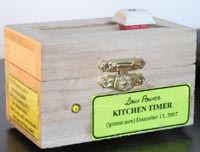
An improved version of the above "One Button Kitchen Timer." This one will not discharge the single AA cell powering the unit during idle times. Additionally, it has two new features --- a Yellow LED letting you know it's in a timing cycle. Further it will beep out (in dit-dah beeps) how long after the "time's-up" beeping started. Short dit pushes of the button add one minute to the total time. A longer, dah, (3/4 second push) add ten minute increments to the total time. You can even add hours. This is done by holding down the button and waiting for a beep. Each beep adds an hour to the total time.
The timer works from a single AA Alkaline or NiMH battery.

It's a touch plate switch with four independent outputs. One touch turns on or off circuit one, two touches, circuit two, etc.
Additionally, each of these circuits have program capability to be toggled at up to ten times from internal memory. It's like having four separate timers with multiple on and off times.
A single bi-color, red-grenn, LED sequentially flashes out time of day. It acts as a unique clock which can be read day or night.
Using the Atmel ATTINY2313 micro-controller, this unit will ride through a power failure of up to five minutes without losing loss of memory. Remote turn-on capability is given through the touch plate capability. This allows up to 100 feet of shielded control line leading to the remote touch plates. Extremely low power consumption is achieved by use of a capacitor type power supply and use of latching relays.

Five automatic water valves are controlled individually. They can be programmed to come on at a given time on an every day, every other day, every third day, etc., sequence.
Further, a valve sequence separate from the alarm time sequence can be activated immediately. Valves are programmed to come on in any sequence and each with individual times on.

It is also a programmable switch. It can memorize on/off times of the touch plate (even on a given day). This can be saved in both temporary and permanent memory storage areas. The permanent memory assures commands are never lost. It also can turn a light or appliance on or off after a given length of time ... up to 42 1/2 hours. It is a clock, flashing out hours and minutes from a single LED. It runs on very low power (one milliamp) and uses a capacitor type power supply for efficiency. 34 separate alarm times can be programmed to toggle the on/off of AC power. The Atmel ATTiny2313 micro-controller operates at 3-5 volts but reliably toggles the 5 volt Omron G6HU-2 latching relay because of voltage doubling effected at the outputs of the chip.

It is also a programmable switch. It can memorize on/off times of the touch plate (even on a given day). This can be saved in both temporary and permanent memory storage areas. The permanent memory assures commands are never lost. It also can turn a light or appliance on or off after a given length of time ... up to 42 1/2 hours. It is a clock, flashing out hours and minutes from a single two-color LED. It runs on very low power (one milliamp) and uses a capacitor type power supply for efficiency. 34 separate alarm times can be programmed to toggle the on/off of AC power.
The Atmel ATTiny2313 micro-controller operates at 3-5 volts but reliably toggles the 5 volt Omron G6HU-2 latching relay because of voltage doubling effected at the outputs of the chip.

It is also a programmable switch. It can memorize on/off times of the touch plate (even on a given day). This can be saved in both temporary RAM and permanent EEPROM memory storage areas. The permanent memory assures commands are never lost. It also can turn a light or appliance on or off after a given length of time ... up to 42 1/2 hours. It is a clock, flashing out hours and minutes from a single two-color LED. It runs on very low power (one milliamp) and uses a capacitor type power supply for efficiency. 34 separate alarm times can be programmed to toggle the on/off of AC power.
The Atmel ATTiny2313V micro-controller reliably toggles the 5 volt Omron G6HU-2 latching relay by direct coupling.
Part 2 -- Projects that use discrete components (mostly CMOS)
Mario Pendulum
(Added September 4, 2012) A simple, fun project --- Make Mario swing periodically. A magnet suspended on a pendulum is deflected periodically by a coil. This project can be powered from the AC line ... or from a 15 volt DC supply or even a 15 volt solar module.
A single IC, a CD4093 and a 2N7000 transistor make up some of the parts.

(Added July 15, 2012) Automatic on for stairway lights. Using a sensitive, under the floor, capacitance sensing system, anyone stepping on either the top or bottom step will activate A.C. lights for the stairs. Aluminum foil sensors are mounted under wooden stairs. The circuit easily detects a body above through the wood, padding, carpet.and shoes.
Click Here for schematic and instructions -- automatic on for stairway lights.

This proximity burglar alarm system can be mounted under the floor to detect people above. Because of its extremely low power drain, "D" cells can power the unit for years.
Click Here for low power burglar alarm proximity system

Single NiCad battery powers bright white LED Flashlight. Schematic
Click Here for LED Flashlight schematic

Water Sensing Alarm to warn of flooding. AC line operated, uses very little power. Complete schematic.
Click Here for Water Alarm schematic

Children's Stop/Go traffic signal light. Powered by a single AA alkaline or NiCad battery, this circuit gives hours of entertainment for the young ones. An automatic turn-off assures that the unit won't be accidentally left on to discharge the battery.
Click Here for Stop/Go Children's Traffic Signal schematic

Proximity Detector schematic. Will work under wooden floors to detect someone crossing above. Extremely low battery power drain -- AA cells last two years.
Click Here for Proximity Detector schematic

SCHEMATIC for useful and fun Touch Plate Switch -- Operates for about five cents a year -- and will accept multiple touch plates attached to long control line.
Click Here for Touch Plate schematic

Need an audible and LED indication when a phone is off the hook? Here's the circuit. It is self powered from the phone line. An unobtrusive audible click is heard about every two minutes when the phone is off the hoook. Additionally, an LED light comes on when the phone has been returned to the hook.
Click Here for "Phone Beeper" -- a zipped file containing instructions and schematic diagram

So, your 9-volt batteries keep dying because you leave the switch on? Here's a solution. This simple, Automatic 9-volt Supply Turn-off Circuit uses only 5 components. Power is automatically turned off after about two minutes. While it was designed originally for my digital voltmeter (which I forget to turn off), it can equally turn off other 9-volt operated devices. No more battery money lost due to forgetfulness!
Click Here for "Auto Off Circuit" --- a zipped file containing instructions and schematic diagram
Wayne's Hobbies
Electronics, Computers, Music Composition, Photography
Check Out These Other Links:.
Wayne's environmental musical compositions in MP3 format (free downloads)
Our most interesting trips around Utah
Vacations, Pioneer Stories, Mormonism, and Genealogy
Contact me at: wsimister@hotmail.com
Modified January 12, 2014